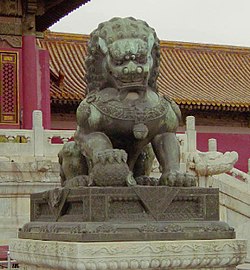Chinese guardian lion
| Chinese guardian lions | |||||||

A Ming Dynasty guardian lion in the Forbidden City
|
|||||||
| Chinese name | |||||||
|---|---|---|---|---|---|---|---|
| Traditional Chinese | 獅 | ||||||
| Simplified Chinese | 狮 | ||||||
| Literal meaning | lion | ||||||
|
|||||||
| Korean name | |||||||
| Hangul | 해태 | ||||||
| Hanja | 海泰 | ||||||
|
|||||||
| Japanese name | |||||||
| Kanji | 狛犬 | ||||||
|
|||||||
| Vietnamese name | |||||||
| Vietnamese | Sư tử đá Shí shīzi |
||||||
| Thai name | |||||||
| Thai | สิงห์ S̄ingh̄̒ |
||||||
| Sinhalese name | |||||||
| Sinhalese | සිංහ siṁha |
||||||
| Burmese name | |||||||
| Burmese | ခြင်္သေ့ hkyin sae |
||||||
| Tibetan name | |||||||
| Tibetan | གངས་སེང་གེ་ gangs seng ge |
||||||
| Transcriptions | |
|---|---|
| Standard Mandarin | |
| Hanyu Pinyin | shī |
| Transcriptions | |
|---|---|
| Revised Romanization | haetae |
| Transcriptions | |
|---|---|
| Revised Hepburn | Komainu |
Chinese guardian lions or Imperial guardian lions, traditionally known in Chinese simply as Shi (Chinese: 獅; pinyin: shī; literally: "lion"), and often called "" in the West, are a common representation of the lion in imperial China. The concept which originated in China, subsequently spread to other parts of Asia including, Japan, Korea, Tibet, Thailand, Burma, Vietnam, Sri Lanka, Nepal, Cambodia and Laos.
Since the introduction of the lion symbolism from Indian culture especially through Buddhist symbolism, statues of guardian lions have traditionally stood in front of Chinese Imperial palaces, Imperial tombs, government offices, temples, and the homes of government officials and the wealthy, from the Han Dynasty (206 BC-AD 220), and were believed to have powerful mythic protective benefits. They are also used in other artistic contexts, for example on door-knockers, and in pottery. Pairs of guardian lion statues are still common decorative and symbolic elements at the entrances to restaurants, hotels, supermarkets and other structures, with one sitting on each side of the entrance, in China and in other places around the world where the Chinese people have immigrated and settled, especially in local Chinatowns.
The lions are usually depicted in pairs. When used as statuary the pair would consist of a male leaning his paw upon an embroidered ball (in imperial contexts, representing supremacy over the world ) and a female restraining a playful cub that is on its back (representing nurture ).
Guardian lions are referred to in various ways depending on language and context. In Chinese they are traditionally called simply shi (獅, Pinyin: shī) meaning lion — the word shi itself is thought to be derived from the Persian word šer. Lions were first presented to the Han court by emissaries from Central Asia and Persia, and by the sixth century AD they were already popularly depicted as guardian figures. Today the guardian lions are more usually specified by reference to the medium or material, for example:
...
Wikipedia
